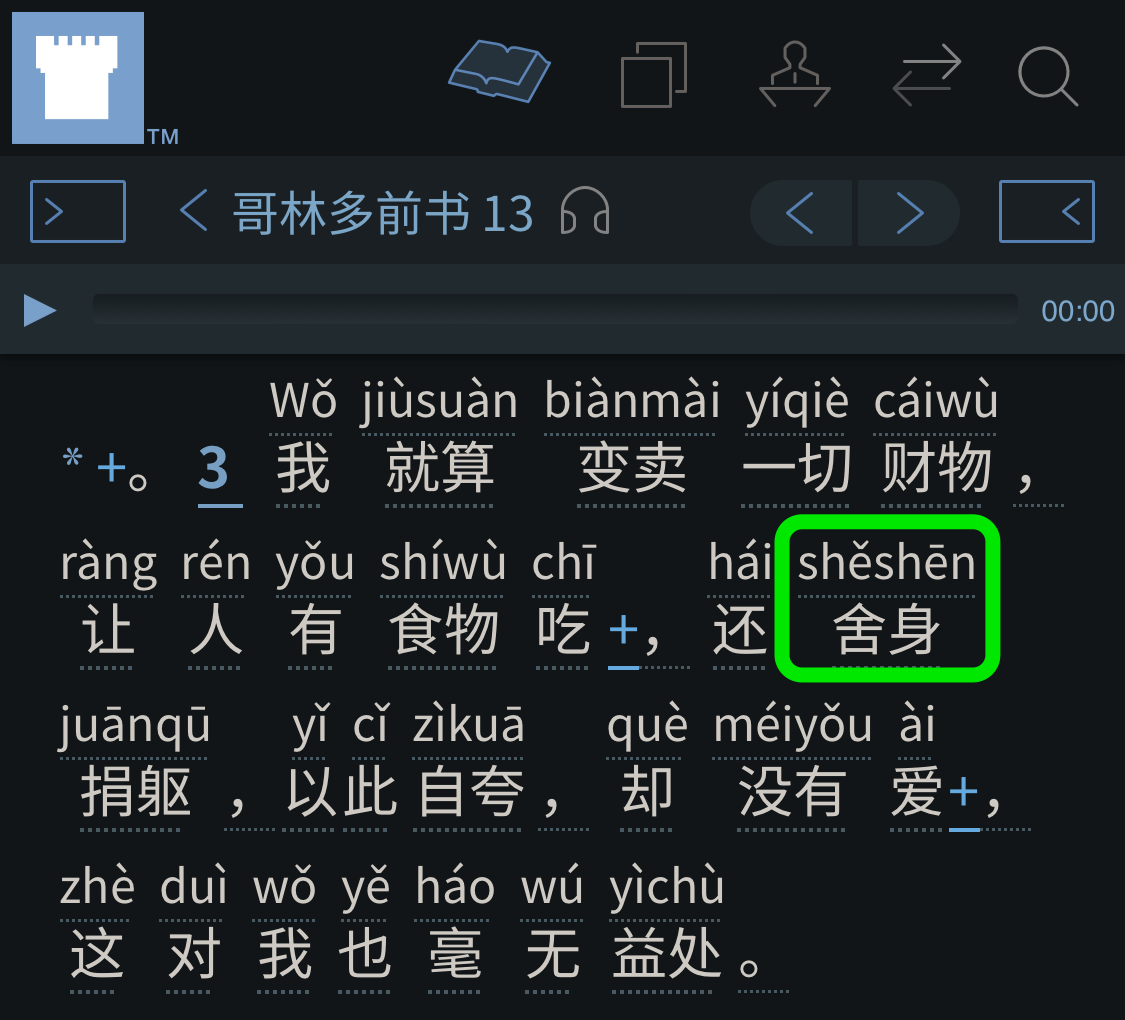gāo’ào (gāo’·ào {[is] (considering self to be of) high (status)} · {[is] proud; haughty; arrogant} 高傲) ← Tap/click to show/hide the “flashcard”
[Notes: Tap/click on a Pīnyīn (Pīn·yīn {Piecing Together of} · Sounds → [Pinyin] 拼音) expression to reveal its “flashcard”; tap/click on a “flashcard” or its Pīnyīn (Pīn·yīn {Piecing Together of} · Sounds → [Pinyin] 拼音) expression to hide the “flashcard”. 📖 📄 📘 icons mean 📖 Reveal All, 📄 Reveal Advanced, and 📘 Reveal None re all the “flashcards” in the heading, paragraph, etc. that they are placed at the beginning of.]
A few years back, I wrote up a brief web page listing reasons for producing Pīnyīn (Pīn·yīn {Piecing Together of} · Sounds → [Pinyin] 拼音), etc. material for the Imitate (ia) book. Some, especially some who grew up in the West, may have felt that this book is made up of “just stories”, and ones that they were already quite familiar with, at that. However, we must remember that Chinese Bible students may often have a different perspective regarding the Bible accounts that are made to come to life in the Imitate book. As that web page said:
- Many Chinese people in the world have not been exposed to Bible accounts the way many Westerners have.
- Also, I have heard that some, perhaps many, Chinese Bible students tend to approach their Bible studies like intellectual exercises for accumulating chōuxiàng (abstract) head knowledge as if for a school exam, rather than as training for their hearts for their own real lives.
Later, the web page touches on how some of the real-world benefits of good storytelling like that found in the Imitate book involve empathy:
- …
- The actress Natalie Portman once said, “I love acting. I think it’s the most amazing thing to be able to do. Your job is practicing empathy. You walk down the street imagining every person’s life.”
- The Imitate book helps build Bible students’ empathy towards Bible characters, which in turn helps Bible students realize that others would feel empathy towards them as well if they imitated these Bible characters—not everyone will just think they’re crazy, like many worldly friends or family members might think.
While even fictional stories can have the benefits described in the links and the quote above, true stories from the Bible can have even greater benefits, including spiritual ones.
Besides the Imitate book, another book from Jehovah’s organization that relates Bible accounts is the Learn From the Bible (lfb) book. The letter from the Governing Body in this book says that, similarly to the Imitate book, the Learn From the Bible book also “brings the Bible accounts to life and captures the feelings of those depicted”, while, unlike the Imitate book, it “tells the story of the human family from creation onward”. While the Learn From the Bible book is especially suitable for children, the letter from the Governing Body in this book says that “it can also be used to help adults who desire to learn more about the Bible”. So, it would be good to consider on this blog some of the expressions used in the Mandarin Learn From the Bible book.
Proud Pharaoh
This week’s MEotW, “gāo’ào (gāo’·ào {[is] (considering self to be of) high (status)} · {[is] proud; haughty; arrogant} 高傲)”, appears near the beginning of Lesson 19 of the Mandarin Learn From the Bible book (WOL), which is entitled “Tóu (Head → [First] 头 頭) Sān (Three 三) Chǎng ([mw for recreational, sports, or other activities] 场 場/塲) Zāiyāng (Calamities → [Plagues] 灾殃 災殃)” (“The First Three Plagues”):
English:
Jehovah sent Moses and Aaron to Pharaoh with this message: ‘Let my people go so that they can worship me in the wilderness.’ Pharaoh proudly replied: ‘I do not care what Jehovah says, and I will not let the Israelites go.’
Mandarin (Pīnyīn (Pīn·yīn {Piecing Together of} · Sounds → [Pinyin] 拼音) Plus):
📖 📄 📘 Yēhéhuá (Jehovah 耶和华 耶和華) pài ({river branched} → [sent] 派) Móxī (Moses 摩西) hé (and 和) Yàlún (Aaron 亚伦 亞倫) qù ({to go} 去) jiàn (see 见 見) Fǎlǎo (Pharaoh 法老), duì (towards → [to] 对 對) tā (him 他) shuō ({to say} 说 說/説): “Nǐ (you 你) yào (must 要) fàng ({let go} 放) wǒ de ((wǒ me 我) (de ’s 的) → [my]) zǐmín (zǐ·mín persons · people 子民) zǒu ({to be walking} → [to be leaving] 走), ràng ({to allow} 让 讓) tāmen (tā·men him/her · [pl] → [them] 他们 他們) zài (in 在) kuàngyě (kuàng·yě spacious · {open country} → [wilderness] 旷野 曠野) chóngbài ({to worship} 崇拜) wǒ (me 我).” Fǎlǎo (Pharaoh 法老) què (however 却 卻) gāo’ào (gāo’·ào {(considering self to be of) high (status)} · proud 高傲) de (-ly 地) shuō (said 说 說/説): “Yēhéhuá (Jehovah 耶和华 耶和華) shuō (says 说 說/説) shénme (shén·me what · [suf] 什么 什/甚麼) wǒ (I 我) bùguǎn (bù·guǎn not · {am managing → [am bothering about]} 不管), wǒ (I 我) jiùshì (jiù·shì exactly · am 就是) bú (not 不) fàng ({letting go} 放) rén (people 人).”
The Mandarin Learn From the Bible book here uses “gāo’ào (gāo’·ào {[is] (considering self to be of) high (status)} · {[is] proud; haughty; arrogant} 高傲)” to correspond with the English word “proud”. A related expression, which also uses the morphemes in “gāo’ào (gāo’·ào {[is] (considering self to be of) high (status)} · {[is] proud; haughty; arrogant} 高傲)”, is “xīngāo (xīn·gāo heart · {[is] high} [→ [[is] proud | [is] having high aspirations/ambitions]] 心高)‐qì’ào (qì’·ào {air → [spirit | manner; attitude]} · {[is] proud; haughty [→ [[is] unyielding]]} 气傲 氣/气傲)”. This expression occurs in Proverbs 16:18 (WOL, Pīnyīn (Pīn·yīn {Piecing Together of} · Sounds → [Pinyin] 拼音) Plus), which is quoted in Lesson 62 of the Learn From the Bible book (WOL, Pīnyīn (Pīn·yīn {Piecing Together of} · Sounds → [Pinyin] 拼音) Plus).
Pharaoh Was a Bozo
The below quote was recently added to the article “Pīnyīn (Pīn·yīn {Piecing Together of} · Sounds → [Pinyin] 拼音) Was Plan A”:
This tendency of many to prioritize their own pride and position over what’s really better for everyone is also described in this quote from Guy Kawasaki about something he learned from Steve Jobs:
A players hire A+ players. Actually, Steve believed that A players hire A players—that is people who are as good as they are. I refined this slightly—my theory is that A players hire people even better than themselves. It’s clear, though, that B players hire C players so they can feel superior to them, and C players hire D players. If you start hiring B players, expect what Steve called “the bozo explosion” to happen in your organization.
Yes, Pīnyīn was Plan A, but China unfortunately let the proud, self-serving B players have their way.
Note that what makes someone a B player or worse is not necessarily that person’s level of intelligence, skill, talent, etc. What characterizes B players or worse is their proud, self-serving rejection of others who are better in some way, their need to feel superior to others.
Pharaoh encountered Jehovah God, an A+ player if ever there was one, and rather than humbly recognizing that, working along with Jehovah, and putting himself in a position to learn from him, Pharaoh in his pride stubbornly rejected Jehovah and his request. He didn’t have to be that way—when the king of Nineveh heard the judgement message from Jehovah that Jonah declared (as discussed in Lesson 54 of the Learn From the Bible book), he and his people repented. Unfortunately, the Pharaoh whom Moses and Aaron faced instead proved himself a bozo.
Psalm 2 prophesies that “the kings of the earth” in general would also “take their stand” against Jehovah and his King Jesus, instead of welcoming and honouring them as they deserve. What a bunch of bozos!
Instead of Following Plan A, China Went with the B Players
Again, as quoted above:
Yes, Pīnyīn was Plan A, but China unfortunately let the proud, self-serving B players have their way.
This is a major reason why China continues to mainly use Chinese characters, when Pīnyīn (Pīn·yīn {Piecing Together of} · Sounds → [Pinyin] 拼音) was introduced decades ago as a simple, elegant full writing system for Mandarin that was meant to eventually replace characters as the main writing system of China, to provide relief for the masses of people who were struggling with the unnecessarily inhumanly complex characters. As the above-quoted article explains:
In addition to those who feel that phasing out the Hànzì would be a regrettable cultural loss, I have also noticed that there are some for whom knowledge of Hànzì is a matter of pride and self-identity. They are proud of knowing the Hànzì as they do, and they view their knowledge of the Hànzì as part of what makes them who they are, as something that distinguishes them from those who don’t know the Hànzì. Such ones may defend the Hànzì to the point of irrationality in the face of a more accessible alternative that would make them and their hard-earned knowledge of Hànzì less “special”, that would threaten to render worthless all of the blood, sweat, and tears they have invested into grappling with these “Chinese puzzles”. It’s as if they are saying, “That’s not fair! If I had to go through all this bitter hard work to learn characters before I could read and write Chinese, then everyone else has to too!”
This is probably a big reason why, as noted above, “opposition [to Chinese writing reform] ‘comes primarily from intellectuals, especially from high level intellectuals.’ ” Lǔ Xùn (鲁迅/魯迅, Lu Xun), considered by many to be the greatest Chinese writer of the twentieth century (he wrote “The True Story of Ah-Q”, “Diary of a Madman”, and “My Old Hometown”), had this to say about the matter:
In addition to the limitations of social status and economic means, our Chinese characters present another high threshold to the masses: their difficulty. If you don’t spend ten or so years on them, it’s not easy to cross this threshold alone. Those who cross over it are the scholar-officials, and these same scholar-officials do their utmost to make writing as difficult as possible because it makes them especially dignified, surpassing all other ordinary scholar-officials.
…
Chinese characters and the Chinese literary language are already difficult enough by their own nature. On top of that, the scholar-officials have purposely devised all of these additional difficulties that get added on. Such being the case, how could anyone hope that the masses would have any affinity for the Chinese writing system? But the scholar-officials precisely want it to be this way. If the characters were easy to recognize and everybody could master them, then they would not be dignified, and the scholar-officials would lose their dignity along with them.
Let Us Allow Ourselves to Be Taught by Jehovah
Let us not be proud B players/bozos like those “dignified” scholar-officials, or like Pharaoh. Instead, let us humbly be open to learning from others, especially from Jehovah God himself. Isaiah 54:13 tells us of the good that can result:
And all your sons will be taught by Jehovah,
And the peace of your sons will be abundant.
For convenience:
The direct link for the Pīnyīn (Pīn·yīn {Piecing Together of} · Sounds → [Pinyin] 拼音) Plus resource for the Learn From the Bible book is:
The short link for Chinese field language-learning links for the Learn From the Bible book is:
More Pīnyīn (Pīn·yīn {Piecing Together of} · Sounds → [Pinyin] 拼音) and Pīnyīn (Pīn·yīn {Piecing Together of} · Sounds → [Pinyin] 拼音) Plus web material based on the Mandarin Learn From the Bible book will be made available in the Pīnyīn (Pīn·yīn {Piecing Together of} · Sounds → [Pinyin] 拼音) Plus web resource as time allows.

